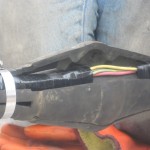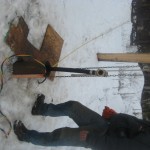
 Towards the end of February we headed to Sun Peaks for 3 days of cross country and one day of down hill skiing. Everybody was quite excited and the day before found us running all over; getting packed, preparing the animals for temporary caretakers and winterizing the buildings for four days with no people.
Towards the end of February we headed to Sun Peaks for 3 days of cross country and one day of down hill skiing. Everybody was quite excited and the day before found us running all over; getting packed, preparing the animals for temporary caretakers and winterizing the buildings for four days with no people.
This was also the day our deep well submersible pump controller decided to pack it in … again. We have had problems with our water system since it was installed just over three years ago, and decided this time that we were going to redo the system; the warranty expired at the end of three years, we were frustrated with it failing frequently and we simply could not justify over $1500.00 to replace a controller that was not reliable.
All of this meant that on returning from Sun Peaks we needed to pull the pump out of our well quickly so we could get water back into the house … life without water quickly becomes no fun. The well is a 130 feet deep and the pump sits almost 120 feet down from the top of the well on a black poly PVC drop pipe. In order to pull the pump out I also needed to pull 120′ of 1-1/4″ PVC drop pipe, 120′ of #6 electric well cable and the 120′ column of water trapped in the drop pipe. The weight of all of this quickly adds up (the numbers below are not completely reliable, but give a general idea of the weight).
pump and motor: 18 lbs120′ Sched 80 PVC pipe: 68.4 lbs [.57 lbs/ft] 120′ water column: 63.6 lbs [.53 lbs/ft]
4 strands of 120′ #6 AWG pump wire: 38.2 lbs [12.58 ft/lb]
The total weight to be lifted was around 188 lbs. I read accounts on the internet of pulling similar pumps where they simply muscled the pumps up hand over hand … sadly I am not that well endowed. I made one attempt to lift the pump unaided and quickly decided I did not want to be in traction for a few weeks. The original pump installer had used an electric winch attached to his pickup truck to pull the pump on a previous occasion. He attached a pulley to the boom of a forklift raised over the well casing and pulled the pump out of the well in steps limited by the height of the pulley over the top of the well. Unfortunately, we were in the middle of winter this time and I was worried about getting vehicles stuck in the deep snow around the well casing. Besides, I do not own an electric winch. Further reading led me to believe that I COULD build a tripod over the well opening and use a block and tackle to pull the pump.
The pump sits close to the bottom of the well (below the static water level of the well) and hangs from the drop pipe. The drop pipe is in turn connected to a pitless adapter; a two piece unit that mounts to the inside surface of the well casing just below the frost line. Water is pumped up the drop pipe, through the pitless adapter and then into a pipe that ultimately leads into the house. Using the pitless adapter means that the water exits the well below the frost line; it cannot be contaminated by surface water, and is not subject to freezing in the winter. In order to pull the pump you thread a large T-handle into the top of the pitless adapter that is usually about 4-6′ below the top of the well casing. Pulling up on the T-handle then separates one piece of the pitless adapter from the other (they mate in a tapered d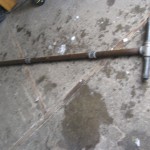 ove tail slot), and the pump can then be pulled straight up out of the well.
ove tail slot), and the pump can then be pulled straight up out of the well.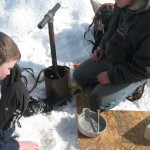
I fabricated a T-handle tool from bits and pieces we had lying around. Typically, a pitless adapter has a 1-1/4″ threaded female pipe adapter to attach the T-Handle. So, I built the tool out of lengths of 1-1/4″ pipe, a T fitting and some couplers; it is 7′ long as the distance from the pitless to the top of the well casing is almost 6′. It was a fairly simple matter to attach the T-Handle with the aid of a flashlight to see what was going on.
Having lots of lumber I built a tripod out of 3 pieces of 16′ long 3×8 timbers. The timbers were definitely overkill for this job, but I was limited in what I had at that length. To form the top of the tripod I attached blocks of wood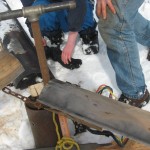 to one end of each timber; each block had a large diameter hole drilled through it, and I passed a length of chain through all three holes and securely joined the ends of the chain together with two bolts. I read about a tripod built from 1″ diameter steel pipe; Each leg was 27′ long with a T fitting threaded onto the top of each pipe, chain was then passed through all three T’s and the ends of the chain were joined together. This tripod would be relatively light, and capable of pulling 20′ lengths of rigid drop pipe from a well. My drop pipe is
to one end of each timber; each block had a large diameter hole drilled through it, and I passed a length of chain through all three holes and securely joined the ends of the chain together with two bolts. I read about a tripod built from 1″ diameter steel pipe; Each leg was 27′ long with a T fitting threaded onto the top of each pipe, chain was then passed through all three T’s and the ends of the chain were joined together. This tripod would be relatively light, and capable of pulling 20′ lengths of rigid drop pipe from a well. My drop pipe is 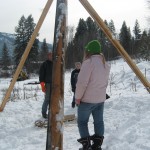 not rigid, and I did not have any pipe on hand … sadly I could not build this monster nor did I have the justification.
not rigid, and I did not have any pipe on hand … sadly I could not build this monster nor did I have the justification.
The timbers were heavy and standing the tripod up was challenging; the kids helped me raise each leg of the tripod a little bit in turn until the assembly was standing centered over the well casing. Surprisingly, this job was done in a couple of hours. Once the tripod was in place I attached a chain hoist (I think it is rated to lift 1500 lbs?) to the chain at the top of the tripod.
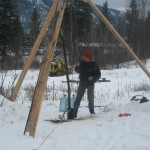 This arrangement ultimately gave me about 7-8′ of vertical lift. This meant that the pump was pulled in 7-8′ increments, and each time the pump had to be held in place while the chain hoist was re-attached for another pull. Holding the pump in place was quite simple; a 120′ nylon safety cord was tied to an eye bracket on the pump and tied off at the top of the well casing to allow for recover
This arrangement ultimately gave me about 7-8′ of vertical lift. This meant that the pump was pulled in 7-8′ increments, and each time the pump had to be held in place while the chain hoist was re-attached for another pull. Holding the pump in place was quite simple; a 120′ nylon safety cord was tied to an eye bracket on the pump and tied off at the top of the well casing to allow for recover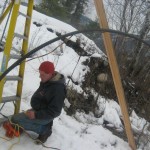 y of the pump if the poly pipe ever failed. We used the safety cord to hold the weight of the pump when we needed to re-attach the chain hoist by double wrapping the safety cord around a large, immovable object (much like belaying in rock climbing). We used a short length of sailing rope tied with a slip knot around the drop pipe .and a bowline clipped to the hook of the chain hoist to attach the drop pipe to the hoist. With this system in place it was a fairly simple though slow process to pull the pump out of the well. The entire job took the better part of the afternoon, and we had the pump pulled out of the well before dinner time.
y of the pump if the poly pipe ever failed. We used the safety cord to hold the weight of the pump when we needed to re-attach the chain hoist by double wrapping the safety cord around a large, immovable object (much like belaying in rock climbing). We used a short length of sailing rope tied with a slip knot around the drop pipe .and a bowline clipped to the hook of the chain hoist to attach the drop pipe to the hoist. With this system in place it was a fairly simple though slow process to pull the pump out of the well. The entire job took the better part of the afternoon, and we had the pump pulled out of the well before dinner time.
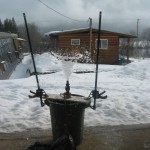 The next morning we were back at it ready to install a new pump in the well. We happened to have a 1/2 hp deep well submersible pump and controller left over from all of the well work we did on our old property. The first order of business was to test this old unit; we placed the pump in a garbage pail filled with water and turned it on. Fortunately, we all got wet! I have no idea from this test if the pump is working to capacity, but at least I felt confident enough to drop it into the well casing.
The next morning we were back at it ready to install a new pump in the well. We happened to have a 1/2 hp deep well submersible pump and controller left over from all of the well work we did on our old property. The first order of business was to test this old unit; we placed the pump in a garbage pail filled with water and turned it on. Fortunately, we all got wet! I have no idea from this test if the pump is working to capacity, but at least I felt confident enough to drop it into the well casing.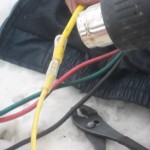
I spent the rest of the morning connecting this pump to the existing electrical lines, and mounting the replacement controller in the pump shed. The connection at the pump needs to be waterproof. We bought a waterproof splice kit from Delta Irrigation in Kamloops. That afternoon we lowered the pump into the well. Going down was much easier than coming up, and this job went quite quickly. By dinner time we had everything hooked up, and were once again pumping water!
The replacement system that we installed has significantly lower flow capacity than the system that was removed. This is a potential issue as we approach summer as the rationale behind the higher flow capacity was fire suppression. I have a few ideas to address this issue but it is a subject for another day. We were out of pocket less than $25.00 on this replacement as we had the old equipment. The pump and controller we used could be bought new for significantly less than $1500.00.







